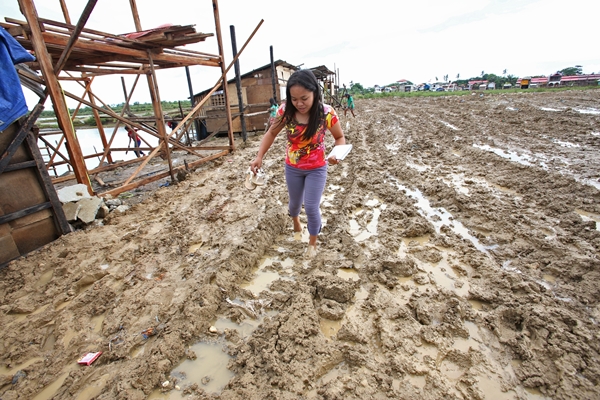
Cebu Daily News Correspondent Anie M. Paujana had to carry her sandals as she was walking on the muddy relocation site at barangay Pakna-an. (CDN PHOTO/JUNJIE MENDOZA)
Elma Remedio arranged her belongings under a plywood roof as her family of seven crowded into the temporary shelter.
The shack is built in part of a a mud-soaked 6.5 hectare relocation site in barangay Pakna-an where they were transferred last Tuesday.
Nursing a bruise sustained during a confrontation with the demolition team, the 51-year-old Remedio told Cebu Daily News that she would rather live in the gutter of M. Logarta Street, than spend one more day at the relocation site.
“Ako na bitaw na gi-ingnan ang taga-demolition, guba-un ninyo akong balay dinhi gyud ko mupuyo sa gutter,” (I’ve already told the demolition team, if you destroy my house I will live here in the gutter),” Remedio said.
For now, she said, she’s focusing on the health of her children.
Tarpaulins, plywood roofs and sacks were used for shelters by 100 residents who transferred from sitio Mahayag, barangay Subangdaku, Mandaue City.
On Tuesday, a 50-man demolition team from Mandaue City Hall started tearing down the remaining 130 houses in the area for encroaching on the 3-meter easement of Mahiga river.
Settlers, who initially resisted, gave up after a fire hose blasted water to disperse a human barricade.
“So far, we haven’t met any trouble in the demolition today, but we’re still expecting the worst,” said Administration Officer Carlo Ybanez of City Legal Office on the second day of operation.
A Special Weapons and Tactics (SWAT)police team stood by as the demolition team took down houses beside SM Hypermarket.
After the area is cleared, a fence will be put up to prevent settlers from returning to the site.
“We are planning to divide the team, to start at the other edge of the area but it may expose our team to harm,” he said after being advised by police that the interior of the sitio was dangerous.
There are 153 houses in sitio Mahayag based on a report from the Housing and Urban Development Office (HUDO) of Mandaue city.
Muddy
About 100 urban poor settlers were transferred to the Paknaan relocation site while the rest will receive cash assistance.
“We’ve been telling the affected residents to come to our office so that we can assist them. Now that their houses were demolished, they have to come to us,” HUDO chief Tony Juanico said.
On heading to the relocation site, one has to turn right from the Cansaga River and go down the muddy main road where trucks of Mandaue City Hall carrying the belongings of the families are parked.
Among those who transferred recently was 30-year-old Madel Casinilla.
“Sulod sa upat ka buwan, okay ra man diri. Dili man sad tinuod ilang gi-ingon nga bahaon, lapok lang gyud siya labi na nga ga-uwan (After four months living here, we are fine. It’s not true that he place is flood prone but it’s muddy especially if it’s raining),” Casinilla said.
Opportunity
When typhoon Mario struck recently, the roofs were not blown off, Casinilla said.
Other settlers like 42-year-old widow Gemma Engaña chose to move to her mother’s home in barangay Mabolo, Cebu City than stay at the relocation site.
She said she had someone take her place in the relocation site and was paid P17,000, the assistance extended by City Hall.
She said she didn’t want her family to stay in a place with no electric power or water connection and was located near a river. “It’s mddy there,” she said in Cebuano.
Juanico said the road and drainage system was still being built and the relocation site would be fully cemented in two to three years.
Occupants will pay the city government P1,800 a month as amortization for the housing program.
“It’s a once in a lifetime opportunity given by the City of Mandaue.They should take this opportunity,” Juanico said. /With correspondent Norman V. Mendoza
Related Stories:
Mahiga Creek settlers in Mandaue City side told to relocate
Mandaue clears structures along Mahiga Creek
Demolition of houses on Mandaue side of Mahiga next week